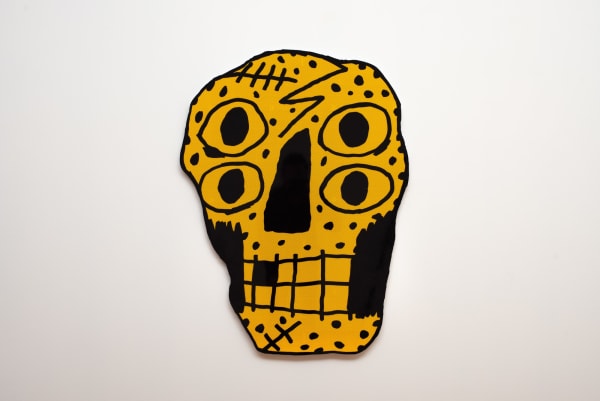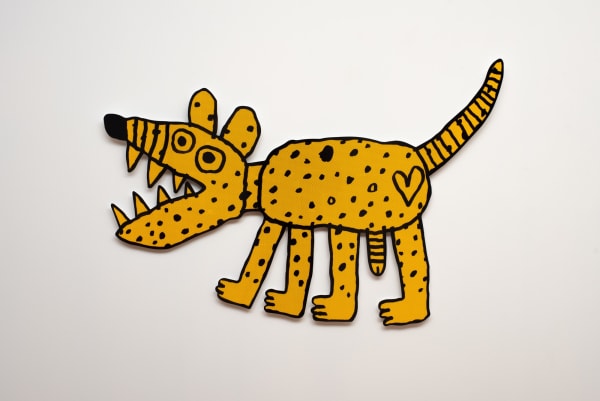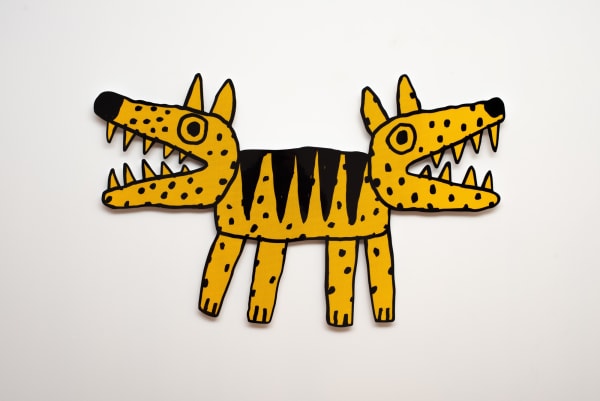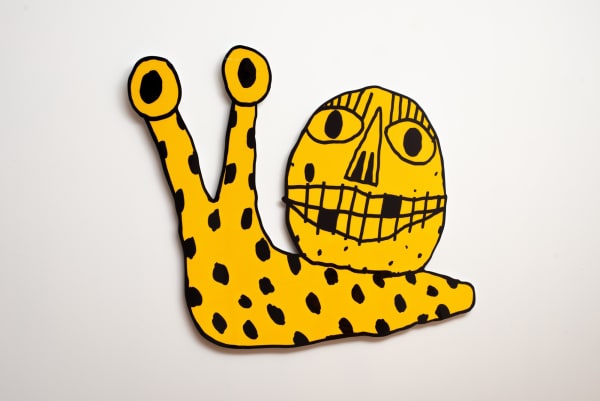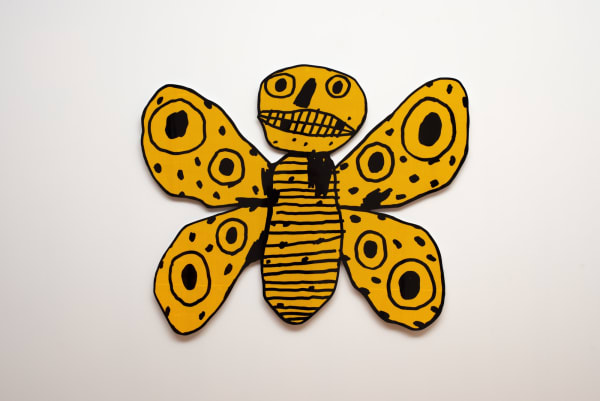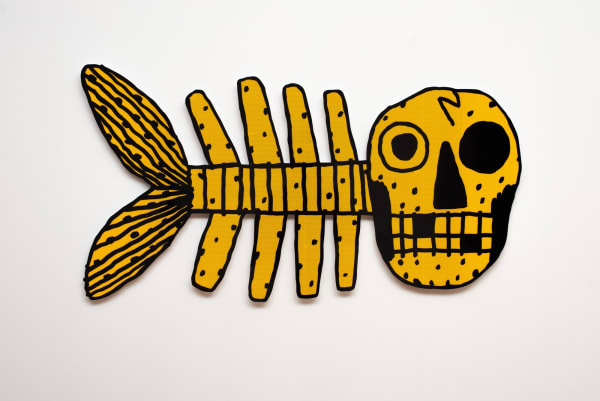Tom O'Hern: Hell Pig
I’ve been thinking about the big boulders we chuck everywhere to stop people doing doughies and how they look like sort of like stonehenge or something.
Hell Pig.
I’ve been thinking about mechanical megafauna rolling around and eating up all the marsupials and cutting up all the hills for roads and the sprawl. A hell pig or entelledont, an ancient pig beast from Europe the size of a hilux with big crocodile jaws.
I’ve been thinking about all the animals we’ve introduced and the continents of North and South America crashing together three million years ago.The plants of Europe have all been trained by glaciers to colonise bare earth and the side of the road getting sprayed pink, green and blue.
I’ve been thinking about the big boulders we chuck everywhere to stop people doing doughies and how they look like sort of like stonehenge or something.
I’ve been thinking about getting tailgated by this car with one headlight and in the mirror how it looked like a big skull with one eye."
Tom O'Hern, 2023
The most disturbing drawing I’ve ever seen in my life turned up in an odd place: the pages of the Kangaroo Creek Gang Club in Hobart’s Mercury in the mid-90s. This page regularly published drawings sent in by children, and one week it sported a child’s drawing of Satan. The image was crude and its presence somehow shocking, with an edge of uncontrolled bedlam suggested by its imprecise contours and sheer expressive evil. What was this doing here, and why on earth was it in newsprint? What it did show me though, was the incredible power a rugged and untutored drawing can have, and how accessing that crude energy might provide a level of emotional resonance that a more sophisticated, or even skilled, drawing might have. The crude rawness shoved the subject matter at me. There was no side stepping into a conversation about the skills of the artist as a way of avoiding the lurching potential this crude and terrifying wonder made me face.
Tom O’Hern is probably one of the most well-recognised artists in Tasmania right now. This is by a kind of design, as he spent a lot of time making work that ended up on the streets of Hobart – indeed there was a moment, perhaps a decade back, where his distinct line and bold TOM signature seemed near ubiquitous. O’Hern made stickers that gave faces to all kinds of public instalments, he drew on nearly any surface he could find, he made stickers of skulls, came up with slogans and just kept going, in a near relentless campaign to mark the city of Hobart with a mess of his own making. Tom’s style of drawing evolved as he went along in an interesting way: when I first encountered his work at Hunter Street, it was a lot more detailed and meticulous, more classically illustrative, and somehow prettier, despite some relatively gruesome subject matter. His gradual shift in style is interesting, as you could say his work became simpler, but that’s not exactly right. Rather his style loosened and his need for realism was slowly ejected for a more chaotic style that has the primitive sophistication one used to find in things like medieval illuminated texts. In these you can find, should you search, all manner of odd and feral beings that are often taking a crap, as Tom O’Hern’s creatures are, or are somewhat oddly demonic entities, like Tom O’Hern’s creatures are.
I think as the strictness of realism was shed, Tom’s output became more tinged with metaphor and idea, although it’s still also about the sheer expressive joy of drawing weird looking stuff. Tom draws what he likes, and what he likes is comically grotesque. It’s just that that’s not all it is. There are two undercurrents I’ve started to identify. One is a kind of occult symbology that may have simply come from an investigation of older images of demonic entities, which is interesting enough in itself, because you could see this as placing O’Hern in a tradition that stretches back centuries and takes in artists like Bosch and Breughel. O’Hern does have fun examining the traditions of the grotesque, and it does link him as well to strains of underground art and non-traditional sources of imagery – like comics or the heavy metal genre. This isn’t so pronounced, but it is there in the mix, and it makes O’Hern more interesting when you realise he’s a magpie who has studied quite widely, and that part of what he’s doing is paying homage to one of the longest running veins of art. Grotesque stuff is possibly also simply more fun to draw, and drawing monstrous creatures is a lot of genuine fun.
The other strain is more interesting and potentially subversive. If we look at the title of this show, Hell Pig, O’Hern is talking about an extinct animal, the entelodont, which was a huge pig with a massive jaw. O’Hern, in an artist’s statement, compares it size wise to a car. What’s really interesting though is that the pig doesn’t feature in the show. What does feature in the show is a lot of deformed and hilarious monstrosities that are all drawn on reflective surfaces that look a lot like road signs, along with a reference to being tailgated by a car that reminded Tom of a skull. There’s a monstrous creature we can’t see that’s the size of a car, and while the terrifying pig is extinct, the car is not at all. Cars take out a lot of Australian animals on the roads, cars kill people, cars pollute and send fossil fuels into the atmosphere. Cars are a problem, which is a terribly interesting thing to consider, because in Australia, we love cars. We associate them with freedom and with status. They are pretty useful, but they are also pretty dangerous, and there’s not enough public transport around to act as a genuine alternative.
Cars are an integral part of Australian culture, so much so that we can’t really understand what Australia would be like without cars, but consider that most cities are designed with the car foremost in mind. Not people or animals, but cars. Hell Pig is, to some extent, a comment on what cars do to animals in Australia, and as such, it’s also a comment on car culture. It’s not a polemic, but the problem of cars being devouring and destructive monsters isn’t something that’s pointed at all that much. Tom does it in something of an oblique way, but the idea is there to be grasped, and if you want to do something really subversive in Australia, critiquing the cult of the car is right up there. Ideas about the effect on Australian animals of colonisation, land clearing and the problems of introduced species are fairly consistent throughout Tom’s art, but Hell Pig is possibly the most overt version of this to date; Tom is certainly doing something a bit more pronounced here in wondering directly about the road toll of Australian animals.
He’s also still Tom O’Hern: even if there are ideas poured into his work, the investment in chaotic and joyful grotesque will always be present and important. The sense of fun is crucial to making it all work. Tom is not interested in the didactic – there’s always going to the pagan necromantic sense of comedy alongside anything he wants to discuss – but the point is that Tom is a lot more than a joker who scribbles on walls, and deserves his place as one of Tasmania’s most engaging and thoughtful artists, who takes some complex ideas to a much broader population.
Andrew Harper review, Make & Do, July 2023
https://makeanddo.art/make-and-do-july-2023/
-
 Tom O'HernHighway Hypnosis, 2023animation3 minsedition of 5 plus 2 artist's proofsAU$ 3,000.00
Tom O'HernHighway Hypnosis, 2023animation3 minsedition of 5 plus 2 artist's proofsAU$ 3,000.00 -
 Tom O'HernDead in a ditch, 2023enamel and reflective vinyl on aluminium119 x 100 x 2.5 cmAU$ 2,950.00
Tom O'HernDead in a ditch, 2023enamel and reflective vinyl on aluminium119 x 100 x 2.5 cmAU$ 2,950.00 -
 Tom O'HernRoad toad, 2023enamel and reflective vinyl on aluminium113 x 119 x 2.5 cmAU$ 2,950.00
Tom O'HernRoad toad, 2023enamel and reflective vinyl on aluminium113 x 119 x 2.5 cmAU$ 2,950.00 -
 Tom O'HernSuicidal sex marsupial, 2023enamel and reflective vinyl on aluminium119 x 78 x 2.5 cmSold
Tom O'HernSuicidal sex marsupial, 2023enamel and reflective vinyl on aluminium119 x 78 x 2.5 cmSold -
 Tom O'HernTwo header, 2023enamel and reflective vinyl on aluminium119 x 72 x 2.5 cmSold
Tom O'HernTwo header, 2023enamel and reflective vinyl on aluminium119 x 72 x 2.5 cmSold -
 Tom O'HernDead set, 2023enamel and reflective vinyl on aluminium119 x 68 x 2.5 cmSold
Tom O'HernDead set, 2023enamel and reflective vinyl on aluminium119 x 68 x 2.5 cmSold -
 Tom O'HernSnot rock, 2023enamel and reflective vinyl on aluminium119 x 84 x 2.5 cmSold
Tom O'HernSnot rock, 2023enamel and reflective vinyl on aluminium119 x 84 x 2.5 cmSold -
 Tom O'HernHell Pig, 2023enamel and reflective vinyl on aluminium119 x 84 x 2.5 cmSold
Tom O'HernHell Pig, 2023enamel and reflective vinyl on aluminium119 x 84 x 2.5 cmSold -
 Tom O'HernFucking beautiful, 2023enamel and reflective vinyl on aluminium119 x 97 x 2.5 cmAU$ 2,950.00
Tom O'HernFucking beautiful, 2023enamel and reflective vinyl on aluminium119 x 97 x 2.5 cmAU$ 2,950.00 -
 Tom O'HernForty spotted handjob fish, 2023enamel and reflective vinyl on aluminium119 x 62 x 2.5 cmSold
Tom O'HernForty spotted handjob fish, 2023enamel and reflective vinyl on aluminium119 x 62 x 2.5 cmSold -
 Tom O'HernDead dog, 2023enamel and reflective vinyl on aluminium119 x 70 x 2.5 cmSold
Tom O'HernDead dog, 2023enamel and reflective vinyl on aluminium119 x 70 x 2.5 cmSold -
 Tom O'HernSatanic flesh lover, 2023enamel and reflective vinyl on aluminium119 x 122 x 2.5 cmSold
Tom O'HernSatanic flesh lover, 2023enamel and reflective vinyl on aluminium119 x 122 x 2.5 cmSold -
 Tom O'HernDead meat, 2023enamel and reflective vinyl on aluminium69 x 119 x 2.5 cmSold
Tom O'HernDead meat, 2023enamel and reflective vinyl on aluminium69 x 119 x 2.5 cmSold -
 Tom O'HernDemon duck of doom, 2023enamel and reflective vinyl on aluminium100 x 119 x 2.5 cmSold
Tom O'HernDemon duck of doom, 2023enamel and reflective vinyl on aluminium100 x 119 x 2.5 cmSold -
 Tom O'HernTurbochook, 2023enamel and reflective vinyl on aluminium105 x 119 x 2.5 cmSold
Tom O'HernTurbochook, 2023enamel and reflective vinyl on aluminium105 x 119 x 2.5 cmSold -
 Tom O'HernBoner, 2023enamel and reflective vinyl on aluminium119 x 64 x 2.5 cmAU$ 2,750.00
Tom O'HernBoner, 2023enamel and reflective vinyl on aluminium119 x 64 x 2.5 cmAU$ 2,750.00


